Governance29
The Open Business Business Case
Cameron Shorter
October 2, 2019
Cameron Shorter
October 2, 2019
This was originally published on http://cameronshorter.blogspot.com/2018/10/the-open-business-business-case.html
Despite many attempts, large companies and governments’ rarely achieve the level of collaboration experienced by Open Source communities. Why?
Looked at through the lens of traditional management, Open Source collaboration is time consuming, imprecise, unreliable, hard to manage, rarely addresses short term objectives, and hard to quantify in a business case. And yet, in a digital economy, collaborative communities regularly out-innovate and out-compete closed or centrally controlled initiatives.
Backing successful collaboration within traditional business requires us to write compelling, counter-intuitive business cases which explain and justify the elusive practices of collaborative communities. This article explains the subtle magic of open strategies in business terms, and will help you convince your boss to back them.
Originally presented at the World Commons Week, November 2018. Youtube recording and slide deck are available online.

Fifty years ago Garrett Hardin described the tragedy of the commons, where people acting in their own self-interest, inevitably will deplete or spoil a common resource, as each acts in their own self interest. He argued that the tragedy can only be prevented by private property rights or government regulation. And yet, within the last fifty years, we’ve discovered exemplar counter-examples where altruism trumps selfishness. Let’s look at the business case behind one of these examples - the Open Source movement.
Despite governments’ and businesses acknowledging the value of Open Source in policies and initiatives over the last decade. And despite numerous attempts, they rarely achieve the level of collaboration experienced by Open Source communities. Why?
Looked at through the lens of traditional management, Open Source collaboration is time consuming, imprecise, unreliable, hard to manage, rarely addresses short term objectives, and hard to quantify in a business case. And yet, in a digital economy, collaborative communities regularly out-innovate and out-compete closed or centrally controlled initiatives. Backing successful collaboration within traditional business requires us to write compelling, counter-intuitive business cases which explain and justify the elusive practices of collaborative communities. This presentation explains the subtle magic of open strategies in business terms, and will help you convince your boss to back them.
I’m going to focus on Open Source Software, but the principles translates across all types of Creative Commons - Open Data, Open Government, Open Standards, and other Open approaches.
This is what we will be covering:
The first thing to recognise is that the Digital Economy has fundamentally changed the rules of business. Ignore this at your own peril. Zero duplication costs and the connectivity of the internet has led to Wicked Complexity, Rapid Innovation, and on the flip side, Rapid Obsolescence.
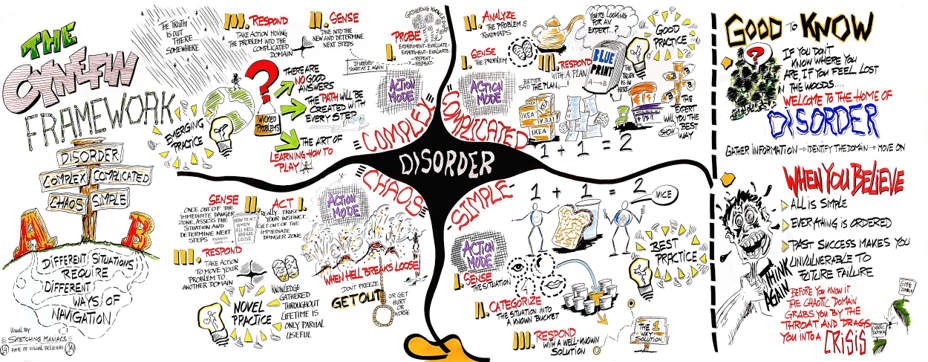
Let’s start by talking about Complexity. Software systems have become huge, interdependent and complex. It is no longer possible for one person to understand all of a system’s intricacies. Solving problems requires the collective brain power of many people.
To understand this, we’ll introduce the Cynefin framework, developed by Dave Snowden when he worked for IBM Global Services. It describes how different decision methodologies should be applied at different levels of complexity. The framework is broken into four decision-making domains.
The Obvious domain is the area of "known knowns".
The Complicated domain is the "known unknowns".
The Complex domain is for the "unknown unknowns".
In the Chaotic domain, cause and effect are unclear, and events are too confusing to wait for a knowledge-based response.
Open source collaboration has proven to be very effective within Complex and Complicated domains, which begs the question of “why”? Why is an open approach so effective within complex domains, and conversely, why aren’t open approaches as dominant in Obvious and Chaotic domains?
A study by Professor Charlie Schweik from the University of Massachusetts, which analysed hundreds of thousands of Open Source projects, produced some interesting findings. Firstly, most projects are abandoned, and of those that succeed, most only have a few developers, with the extra developers often coming from another country. (Source data)
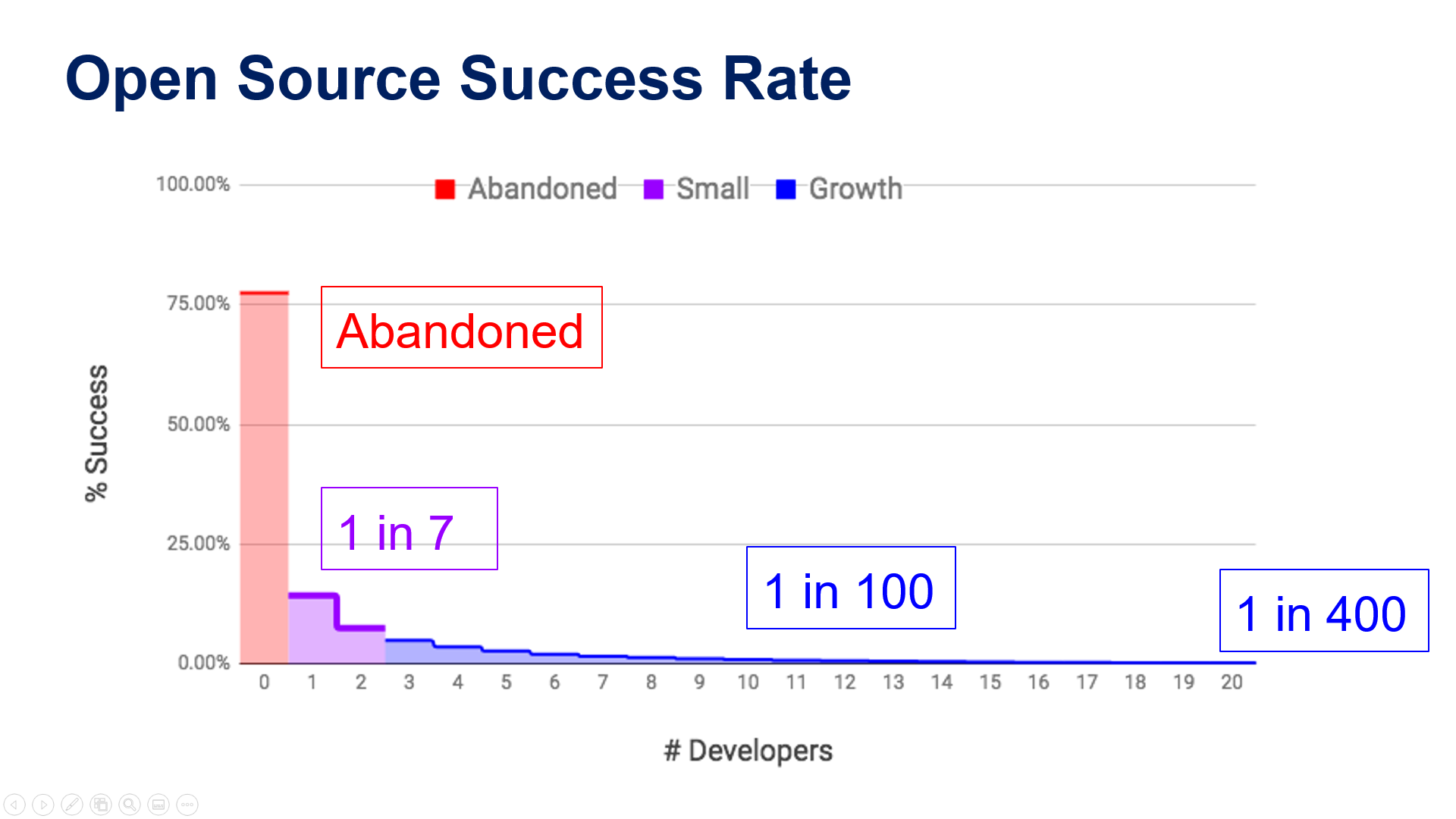
On this graph we’ve drawn in the success rate for the projects. As you attract developers, your chance of long term success increases dramatically. This is showing ruthless Darwinian evolution at work.
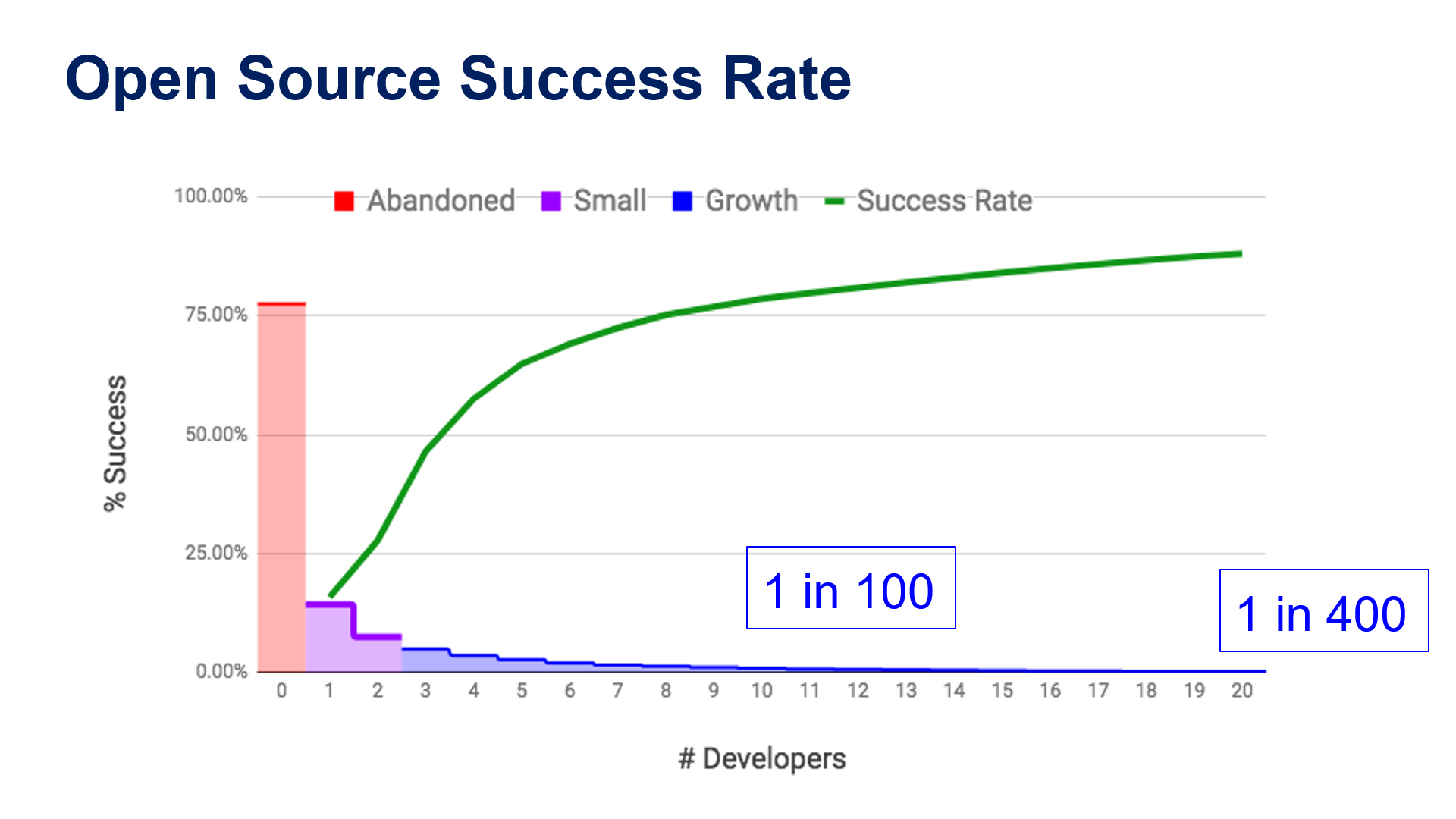
Effectively, Open Source is an environment where lots of competing ideas are tested. Only projects of exceptional quality attract sustained growth and large communities. And this is a key characteristic to notice. When you are giving away your software for free, success depends upon:
The study also noticed that projects which grow typically provides fine scaled task granularity and makes it easier for people to contribute. As well as having attracted financial backing.
And here we start to uncover the magic of Open Source. In the digital economy, there are more developers working on your problem, than you will ever have in your team. When projects can tap into this, Collaboration out-competes competition!
Let’s look at one of the key factors in complicated systems - trust; and question what makes trustworthiness.

It turns out we all make use of a variant of this trustworthiness equation.
We also trust processes.
But, we also know that all processes can be gamed. And the more complex a system, the easier it is to bamboozle people, and game the system.
Part of the reason Open Source has been so successful is that it’s characteristics lead to trustworthiness. These include:
Let’s look at these in more detail.
… starting with Freedom and Altruism.
Open source, by definition, is given away for free, with the freedom to use and extend it as you see fit. Why are Open Source developers so altruistic?
It turns out that it is wrong to assume that we humans are only driven by self interest. As noted by Dan Pink in his book Drive, after our basic needs are met, we are also motivated by …
Such altruistically motivated people, who provide significantly more value to the receiver than to the giver, increases the trustworthiness of the giver.
Then there is Openness. Openness and transparency is almost universally applied to all Open Source development and communication.
Being transparent and open to public critique reduces the potential for hidden agendas and creates trustworthiness. And within Open Source communities, decisions tend to be made bottom-up rather than top-down. When you can trust the motivations of your community, you are empowered use of bottom up decision making.
This is important, because in a complex system, the person closest to the problem is usually the best qualified to make decisions.
It creates a culture of “do-ocracy”. Within a do-ocracy the person motivated to do the work decides what gets done. Their commitment is a better indicator of true value than a person at the top saying “someone should fix this”.
This leads into Meritocracy. In a meritocracy, the best ideas win, no matter who suggests them. It is the sign of an egalitarian community rather than a hierarchical or dysfunctional one.
But we should be careful not to suggest that open practices easily solves all problems. Open Source projects are highly susceptible to being Loved to Death. This happens when a project attracts an engaging user base without attracting matching contributions. Volunteer become overwhelmed leaving insufficient capacity to cover essential business-as-usual tasks. Don’t to overload the community you depend upon. It is both bad karma and bad business.
Successful projects have worked out how to either:
If your organisation isn’t ready to act as a good community citizen, actively caring about the community’s long term sustainability, then you will probably have a disappointing Open Source experience. You will make self-centred, short term decisions, and you won’t get the support you need when you most need it. You will likely be better off with proprietary software. (And the community would be better off without you.) 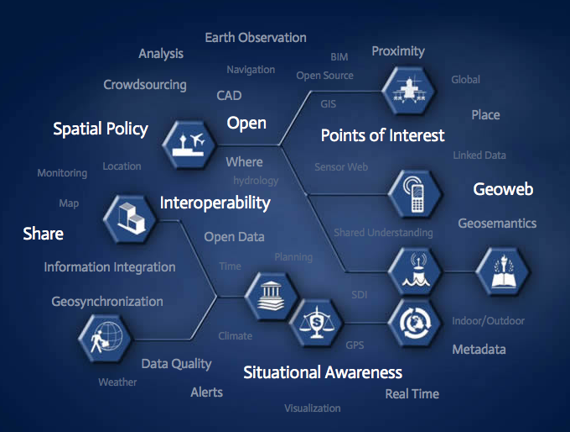
A key strategy for managing complexity is to divide large systems into modular subsystems. Using modular architectures, connected by open standards:
It means you can improve one module, without impacting the rest of your system.This helps with maintenance, innovation, and keeping up with latest technologies. Collaboration is a key focus of both Open Source and Open Standards narratives. Hence, successful Open Source applications usually provide exemplary support for standards.
By comparison, from the perspective of dominant proprietary companies, it makes business sense to apply vendor lock-in tactics, making cross-vendor integration difficult. Adoption of Open Standards threatens vendor lock-in tactics, and consequently dominant vendors are often reluctant and half-hearted in their support of Open Standards. Effectively, we are talking about monopolies.
Because software is so time consuming to create and so easy to copy, it is excessively prone to monopolies. This holds true for both proprietary and Open Source products. A product that becomes a little better than its competitors will attracts users, developers and sponsors, which in turn allows that product to grow and improve quickly, allowing it to attract more users. This highly sensitive, positive feedback leads to successful software projects becoming “category killers”.
This means that most of the software you own is likely to be out-innovated within a year or two. Your software is not an asset, it is a liability needing to be updated, maintained, and integrated with other systems. It is technical debt, and unless a product is part of your core business, you should try to own as little of it as possible. The question is: should you select Proprietary or Open Source as the alternative?
Open Source and Proprietary business models differ in how their realised value is shared. Open source licenses are structured such that multiple companies can use and support the same Open Source product, so the market self corrects any tendencies toward price-fixing. It enables everyone to share in the value created by technology.
By comparison, the ruthless competition between proprietary companies results in “winner takes all” scenarios. Many of the richest people in the world are self made software entrepreneurs. These are typically people and organisations who have mastered the Complex domain.
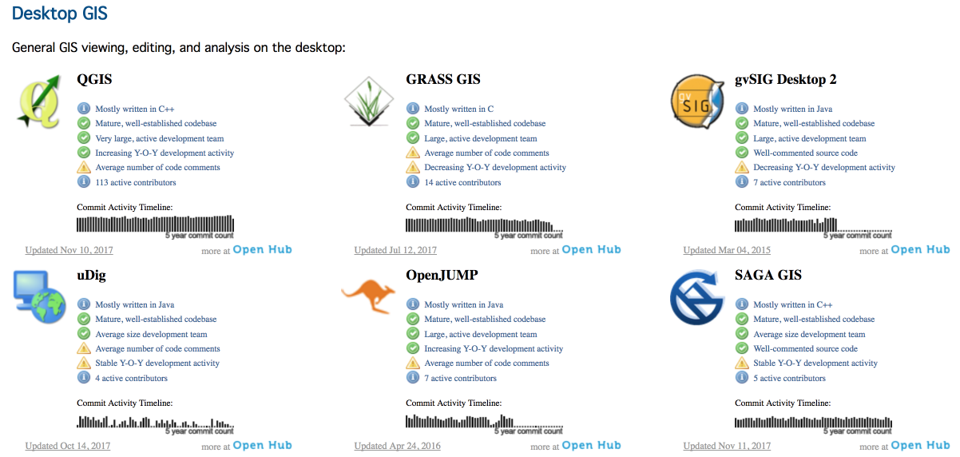
Let’s take a quick look into the indicators for successful open projects. To get insights into project health, you can look at Open Hubmetrics. In particular, look for signs of sustained collaboration and growth. Another strong indicator of a project’s success is whether it has completed an Open Source Foundation’s incubation process. I’ve been involved with the Open Source Geospatial Foundation’s incubation process where we look for indicators of:
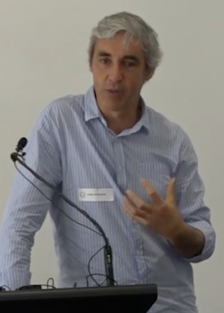
© 2018 Cameron Shorter. The text behind this article, is licensed under a Creative Commons Attribution 4.0 International License.
Please subscribe and become a member to access the entire Business Agility Library without restriction.